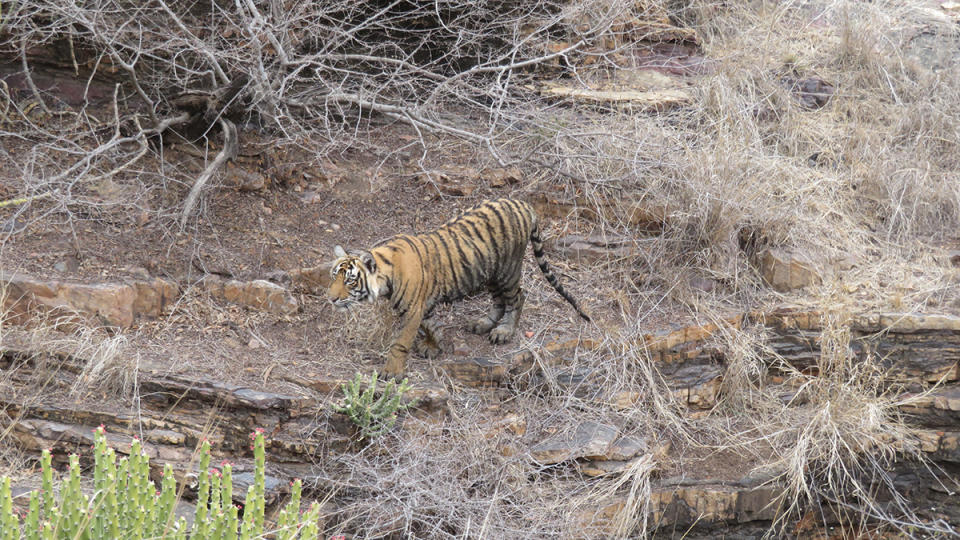Meet Vijay Kumawat, the Only Private Guide in India’s Most Renowned Tiger Sanctuary

In Africa, serious safari addicts won’t settle for the camp guide. Instead, they travel with a private guide who knows and specializes in their particular interests and goes where they go. But in India, where tiger safaris attract less repeat visitors and sightings are more elusive, the market for private guides is substantially smaller—in fact, there is only one: Vijay Kumawat.
A naturalist based in Ranthambore National Park in Rajasthan, Kumawat works primarily with the Relais & Châteaux SUJÁN Sher Bagh hotel. But unlike other tiger safari guides—who are expert spotters but often lack the level of training and expertise common in Africa—he’s put his superior know-how on the free market. As a freelance guide, Kumawat has quickly become one of the most in demand tiger touts in the region with a growing number of repeat, and unmentionably A-list clients.
More from Robb Report
Ask Robb: Help! I've Seen It All on Safari-Including the Big 5. What Now?
You Can Now Drive a Porsche Through 5 African Countries With This New Off-Roading Experience
This African Safari Lodge Just Got a Luxe Makeover. Here's a Look Inside.
We spoke to him about his journey, Ranthambore’s best-kept secrets, and more.

You come from a family of artisans. How then did you become a naturalist?
When sandalwood and ivory were banned by the Indian government, my father started dealing in wildlife literature and art. He worked with local artists to supply wildlife-themed paintings and often sent me to their homes to collect these paintings. There was a lot of waiting around, so I started emulating their work. I’d work on close-ups of the tiger’s eye, nose or paw and it turned into an addiction. After school, I started working on my own art and practiced until I got better at it. I’ve exhibited my artwork all over India and in European countries like Poland and Denmark.
While I was still in school, I started accompanying these same artists to treks in the periphery of Ranthambore National Park. I was just a young boy of 15 but my father instilled a lot of confidence in me to go and explore and not fear anything. These trips lasted four or five days at a time; we used to camp and cook our own meals. It became a practice to go to the jungle with my sketchbook and practice drawing whatever we saw around us from mammoth banyan trees to small mammals. Slowly, I began to fall in love with the jungle. I decided to be a naturalist because I wanted to show people my Ranthambore and be a representative of my hometown.
What makes Ranthambore stand out from other tiger parks in India?
Ranthambore is a dry deciduous forest and that particular habitat makes it possible to get really good tiger sightings. It is different from other national parks because there’s a lot of diversity in the landscapes of each zone open to tourists. You have tropical jungles in Zones 1 and 2, lakes in Zone 3, grasslands, and open plateaus in Zones 6 and 10. The other differentiating factor is that there’s a lot of heritage architecture here. Ranthambore Fort is a very majestic structure and is the only fort located in the middle of a national park. Some hotels offer tours with a historian or guide.

What was your best sighting?
I once saw a ferocious fight between a male and a female tiger. The female was Arrowhead (T84) who is the granddaughter of Ranthambore’s most famous tigress, Machhli. The younger male tiger was T120, who is also from the same family. As soon as we entered, we got a tip that two tigers had been spotted earlier; Arrowhead had gone down into the valley while T120 had gone up to the fort. We waited on the narrow road until I saw some dust flying ahead and stood up in my jeep. I saw a tiger making a kill: T120 was suffocating a large sambar deer. He had been hiding because he wanted the deer to come within his reach. But then some forest guards approached on a motorbike and hearing the loud sound, T120 left his prey and moved into the bushes. As soon as this happened, we saw Arrowhead behind our jeep eyeing the carcass. She brushed past us and then started feeding on the free food that T120 had killed minutes earlier. Technically these two tigers are a couple and have even mated and had cubs, but when T120 saw Arrowhead feasting on his kill, he came charging down and they had a terrible, terrible fight. I’ve never seen anything like it ever. After getting three or four slaps by T120, Arrowhead surrendered. I could hear her panting loudly and she was practically bowing on the ground with her shoulders up and tail flicking to say: “I surrender.” But he was so angry, he beat her once again and then pushed her into the valley.
Were you scared watching the fight?
Not at all, I was thoroughly enjoying myself, and it is one of my best memories. As long as one stays in the jeep, one does not need to be scared of tigers.
What are some of the other treasures of the jungle?
People get obsessed with tigers but I think it’s important to appreciate the jungle experience and other wildlife. Besides tigers, there are many other cats in Ranthambore such as the extremely rare melanistic jungle cat, leopards, the desert cat, and caracals. There is wildlife beyond big cats like sloth bears and hyenas. The Chambal Crocodile Sanctuary is 40 kilometers from Ranthambore and you should stay an extra day and visit it. Government boats take you into the Chambal River to spot the endangered gharial crocodiles and marsh crocodiles. The Khem Vilas Hotel also offers Chambal boat rides as a curated experience to their guests.
Tell us a Ranthambore secret.
There are some heritage gems that barely any people know about. At the back of Ranthambore Fort, there’s a gate called Satpol gate, which is an ancient marvel with beautiful design and stone carvings. There are also 1,000-year-old fresco paintings in good condition inside the fort in a temple called the Lot Ram Ji – Sita Ram Ji temple. It’s a bit out of the way so people don’t typically visit, but all four walls and the door are covered with frescos that still have the original pigments. The paintings depict village scenes such as people carrying water in terracotta pots from the river. There’s no light in the room so I use my mobile torch to view them and show them to guests and explain how people lived back then. Heritage like this must be shown to travelers and as an artist, I really appreciate it.
What should first timers think about?
My first tip would be to wear clothes that blend in, browns, greens, and camouflage prints. Don’t dress in stark, contrasting colors that will disturb the animals. May is the peak of summer but also when you get the best sightings (and there’s no chance of unseasonal rain) so I recommend coming then. To make the most of your jungle experience, carry a pair of binoculars to spot birds and smaller animals as well as a notebook to note down your observations at the end of the day.
Best of Robb Report
The Ultimate Miami Spa Guide: 15 Luxurious Places to Treat Yourself
The 7 Most Insanely Luxurious Spas in the World, From Tokyo to Iceland
17 Reasons the Caribbean Should Be at the Top of Your Travel Itinerary
Sign up for Robb Report's Newsletter. For the latest news, follow us on Facebook, Twitter, and Instagram.

